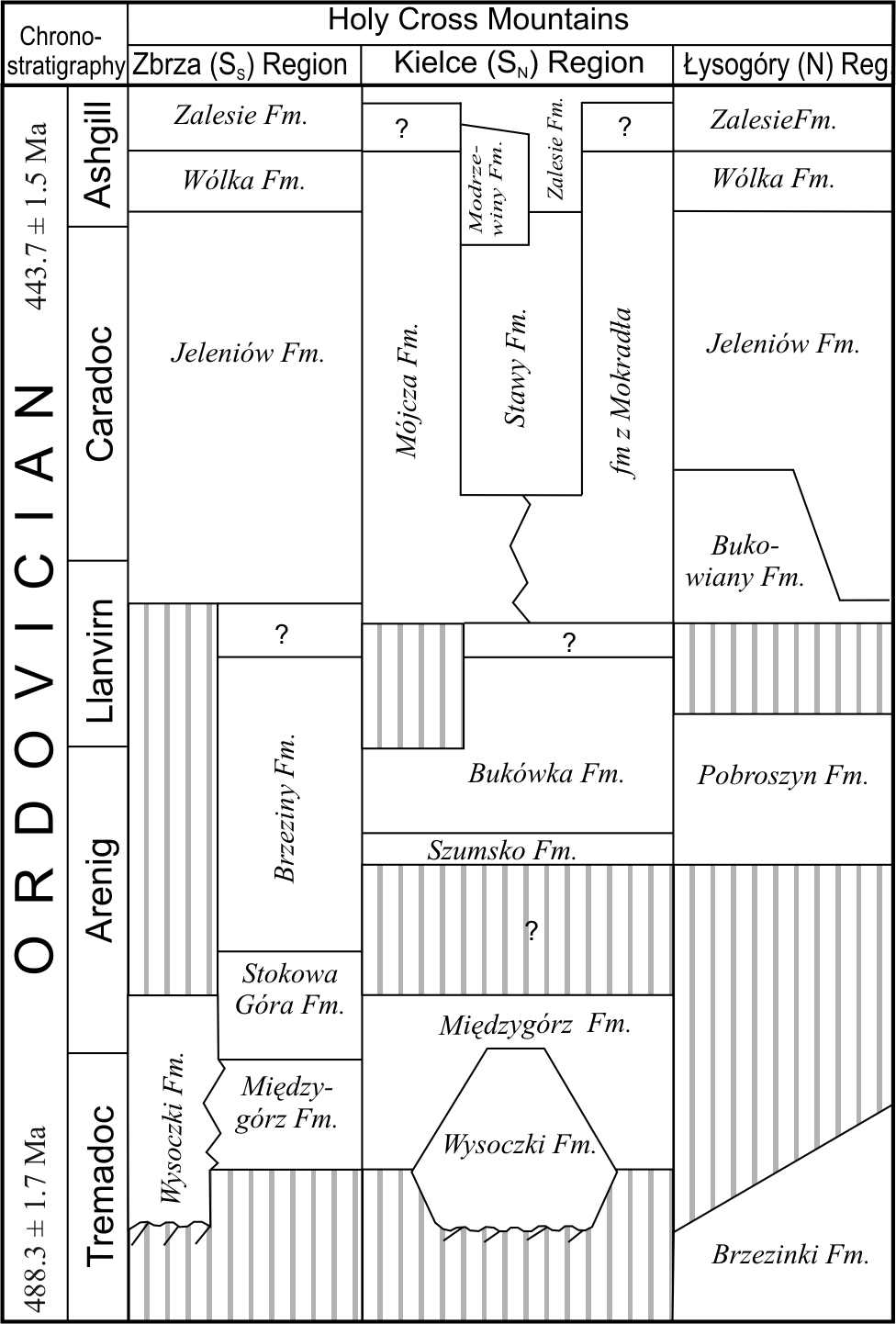Author of the elaboration: prof. dr hab. Stanisław Skompski
A distinctive feature of the Ordovician succession in the Holy Cross Mountains (Fig. 3) are large thickness variations between particular formations and a small total thickness in comparison to the total thickness of the Cambrian rocks; usually it does not exceed 200-300 m. Ordovician rocks of the Holy Cross Mountains originated in completely different settings than the Cambrian strata. In earliest Ordovician times the sedimentary basin of the Kielce Region had undergone structural remodelling; the older rocks were folded, uplifted and eroded, and the Ordovician strata were deposited on them with a distinct angular unconformity, clearly visible in two exposures in the eastern part of the Bardo Syncline. This Early Ordovician tectonic event is interpreted as the Sandomierz tectonic phase or orogeny. For the first time in its Phanerozoic history, the area of today’s Holy Cross Mountains became a mountainous region. It cannot be precluded, however, that local tectonic disturbances in the Kielce Region began earlier, even in mid-Cambrian times, resulting in wide stratigraphic gaps between the Cambrian rocks and the transgressive Ordovician deposits. According to Jaworowski and Sikorska (2006), this tectonic activity could be linked to the rotation of basement blocks, those that determined the boundaries of Cambrian sedimentary basins. The close vicinity of the Holy Cross Mountains area to the margin of the Baltica palaeocontinent is also documented by palaeomagnetic and palaeontological data (Nawrocki et al. 2007; Trela 2009).
A completely different situation is observed in the Łysogóry Region, where there was continuous sedimentation of marine shales at the Cambrian/Ordovician boundary. However, sedimentary gaps also occur here, although noticeably later than in the Kielce Region (compare Trela 2009). Facies variability is a characteristic feature of the upper Lower and Middle Ordovician in both regions of the Holy Cross Mountains (Tomczyk and Turnau-Morawska 1967; Bednarczyk 1981; Trela 2006). The sediments include various sandstones, claystones and carbonates, but their contacts with the over- and under-lying rocks usually contain stratigraphic gaps.
A clearer arrangement of the facies pattern took place in the Late Ordovician (Fig. 3)

Fig. 3. Simplified lithostratigraphic scheme of the Ordovician in the Holy Cross Mountains (after Tabela Stratygraficzna Polski [Stratigraphic Chart of Poland] 2008; Trela 2006)
A clearer arrangement of the facies pattern took place in the Late Ordovician (Fig. 3). Three zones of marine sedimentation became distinct at that time: a northern (corresponding to the Łysogóry Region), a central and a southern zone; the latter two comprise the Kielce Region, represented in its southernmost part by the Zbrza area. The central part is characterized by carbonate sedimentation of small thickness reaching slightly over a dozen metres (stratigraphic condensation) that can be perfectly observed in the Mójcza exposure. In basins surrounding this central zone were deposited claystones with abundant graptolites and thickness several times exceeding the thickness of the Mójcza limestones (above 100 m). A specific feature of the successions of this age is the presence of numerous bentonite horizons, which provide evidence of volcanic activity in the vicinity of the Holy Cross Mountains (Chlebowski 1971; Trela 2005).
At the end of the Ordovician, a distinct shallowing of the sedimentary conditions took place. The claystones were replaced by mudstones characterised by lighter colours and the presence of benthic organisms (brachiopods and trilobites) typical of cool waters (Hirnantia assemblage). In the carbonate successions of the central zone this facies change was more subtle – in an unchanged lithology appeared very clear cyclic microfossil blooms – conodonts from the genus Scabbardella – which are linked with decreasing sea water temperature (Dzik 1999). Thus, symptoms of climate cooling can be observed in all parts of the Holy Cross Mountains basin; they can be attributed to glaciation of the Gondwana palaeocontinent, which was at that time located in the area of the South Pole. An obvious conclusion is that the reason for the appearance of the Late Ordovician regressive facies was the preservation of large water masses within the vast southern ice sheet.



